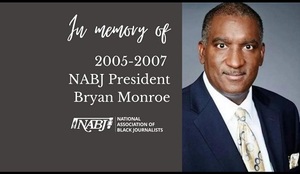 |
IN MEMORY OF JOURNALIST BRYAN MONROE |
By: Richard Prince, Journal-isms
N2Entertainment.net
There was the time Bryan Monroe became part of a delegation that met secretly with the musical icon Prince before what would be one of his last public appearances. That was at the National Association of Black Journalists convention in Minneapolis in 2015.
But, there was also a remembrance of when Monroe, then obese, fell into a diabetic coma after a 2004 meeting in Washington of the American Society of Newspaper Editors. Colleagues rushed him to the hospital, where Monroe was warned that if he didn’t lose weight, he wouldn’t see his kids grow up.
Those were just two of the remembrances that surfaced recently during a nearly two-hour Zoom call described as a “collective hug” by Dorothy Tucker, NABJ president, and “therapeutic” by Jerry Ceppos, a veteran journalist who worked with Monroe at the San Jose Mercury News and helped rush him to the hospital that day in 2004.
Monroe, a journalism professor and former NABJ president who shared in a Pulitzer Prize, died Jan. 13 at his suburban Washington home after a heart attack. He was 55. Forty-two of his NABJ colleagues, including seven former NABJ presidents, were on the Zoom. So were colleagues from CNN Digital, where he had been op-ed editor and editor of CNNPolitics; Johnson Publishing, where he was vice president and editorial director at Ebony and Jet magazines, and Temple University, where he was Verizon chair and professor at the Klein College of Media and Communication.
The National Association of Black Journalists alerted members to the Saturday Zoom celebration.
David Boardman, dean of the Lew Klein College and who hired Monroe to teach there, announced that the family is establishing a scholarship there in Monroe’s name.
The NABJ call was recorded and may be viewed here. It was organized by Tucker and Herbert Lowe, who immediately preceded Monroe as NABJ president and wrote his own tribute at The Undefeated.
Lowe had organized another Zoom call where, Lowe wrote, “Two dozen of us the night he died spent nearly three hours remembering Bryan. . . . It was incredibly joyous and heartbreaking, loving and cathartic, emotional and resolving for us to recall his friendship, spirit, encouragement, generosity, confidence, leadership, vision, hugs, love for his family – and, yes, his willingness to pick up the check for expensive meals and alcohol.”
Saturday’s call had many of the same qualities.
“He would hold court and tell such great stories,” said Meredith Artley, who as senior vice president and editor in chief at CNN Digital worldwide was Monroe’s boss at that network. “He had this general charisma that was so powerful. He was always talking about connecting the dots. He was the guy who everyone wanted to be around.”
Akili Ramsess, executive director of the National Press Photographers Association, recalled how Monroe, the “happy warrior,” recruited her to chair NABJ’s Visual Task Force. “He would see something in you and pull it out,” taking you “to levels you didn’t even imagine for yourself.”
Herbert Lowe wrote of Bryan Monroe’s tenure at Johnson Publishing Co., “his greatest contribution was getting Ebony and Jet ready for the Obama moment.”
Errol Cockfield, a former Newsday journalist and NABJ regional director who is now senior vice president, communications at MSNBC and NBC News, told the group, “He gave me a sense of what’s possible for a Black person. I saw in him how to be a leader. He was comfortable in his own skin as a Black man.”
Sonya Ross, longtime Associated Press reporter now editor in chief at Black Women Unmuted,recalled challenging Monroe’s decision at Ebony to advocate “burying” the n-word.
How can you get rid of a word? Ross asked. Their debate continued for years, she said. “I’m a little bit sad that we won’t be able to debate the merits and demerits of this epithet” any longer, Ross concluded.
Sarah Glover, immediate past NABJ president and, like Monroe, a photographer, said, “His footprint was beyond the two years he served as president,” 2005-2007, a time when she was the board secretary. “He’s been shaping the lives and careers of so many of us.”
Syb Brown, a professor of journalism at Belmont University in Nashville known as “Dr. Syb,” told the story of Monroe’s enviable luck in securing access to the meeting with Prince at the Minneapolis convention. She called Monroe “the person with the big enough shoulders. Sometimes God makes us big for a reason.”
Two other association presidents were present, Mira Lowe of Journalism & Women Symposium (JAWS), who under Monroe became the first female editor of Jet, and Sharif Durhams of the National Lesbian and Gay Journalists Association, known as “NLGJA: The Association of LGBTQ Journalists.” Dunham and Monroe served together as judges in the National Headliner Awards.
In addition to Tucker, Lowe and Glover, NABJ presidents on the call were: Bob Butler, Gregory H. Lee Jr., Kathy Times, Will Sutton and Arthur Fennell.
Butler spoke for many when he concluded his remarks with, “I’m glad to see my family.”
EDITOR'S NOTE: Washington Post journalist Richard Prince occasionally submits his column "Journal-isms" to "Media Matters." Prince's "Journal-isms" originates from Washington, D.C. To check out Prince's complete "Journal-ism's" columns log on to: http://mije.org.
|